Varied difficulty levels in AP Inter 1st Year Zoology Model Papers Set 6 cater to students with diverse academic strengths and challenges.
AP Inter 1st Year Zoology Model Paper Set 6 with Solutions
Time : 3 Hours
Max. Marks: 60
General Instructions:
Note : Read the following instructions carefully.
- Answer All questions of Section A. Answer ANY SIX questions in Section B and answer ANY TWO questions in Section C.
- In Section A questions from Sr. Nos. 1 to 10 are of “Very Short Answer Type”. Each question carries TWO marks. Every answer may be limited to 5 lines. Answer all these questions at one place in the same order.
- In Section ‘B’, questions from Sr. Nos. 11 to 18 are of “Short Answer Type”. Each question carries FOUR marks. Every answer may be limited to 20 lines.
- In Section ‘C’, questions from Sr. Nos. 19 to 21 are of “Long Answer Type”. Each question carries EIGHT marks. Every answer may be limited to 60 lines.
- Draw labelled diagrams wherever necessary in Sections ‘B’ and ‘C’.
Section – A (10 × 2 = 20 Marks)
I. Answer all the questions (Very short answer type)
Question 1.
What is Trinominal Nomenclature ? Give an example.
Answer:
Trinomial nomenclature is the extension of the binominal system of nomenclature. This system permits the designation of subspecies with a three worded name called trinomen. Subspecies is category below the level of species. Eg: Corvus splendens splendens.
Question 2.
What is Cephalization ? How is it useful to its possessors ?
Answer:
Cephalization is concentration of nerve and sensory cells at the anterior end. As a result of cephalization, bilaterally symmetrical animals can sense the environment into which they enter and respond more efficiently and quickly.
Question 3.
Distinguish between tendon and a ligament.
Answer:
- Tendons attach the skeletal muscles to bones.
- Ligaments attach bones to other bones.
Question 4.
Define Osteon.
Answer:
In a dense bone a Haversian canal and the surrounding lamillae (rows of osteocytes) and lacunae are collectively called a Haversian system or Osteon.
![]()
Question 5.
What are the functions of canal system of sponges ?
Answer:
Sponges have a water transport system or canal system that constantly conducts water. It helps in gathering food (filter feeders), exchange of gases (respiration) and removal of wastes (excretion).
Question 6.
What are the jacobson’s organs ? What is their function ?
Answer:
Jacobson’s organs, the specialized olfactory structures which are highly developed in lizards and snakes.
Question 7.
Distinguish between prater and opisthe.
Answer:
During transverse binary of paramecium, two daughter paramecia are formed. The upper or anterior one is proter which receive upper contractile vacuole, cytopharynx and cytostome of its parent. The lower or posterior daughter is opisthe which receives the posterior contractile vacuole only.
Question 8.
Define conjugation with reference to ciliates. Give two examples.
Answer:
Conjugation is a temporary union between two senile ciliates that belong to two different mating types for the exchange of nuclear material and its reorganization. This is observed in Paramoecium and Vorticella.
Question 9.
A person is suffering from bowel irregularity, abdominal pain, blood and mucus in stools etc. Based on these symptoms, name the disease and its causative organism.
Answer:
The disease is Amoebic dysentery or Amoebiasis. The causative organism is Entamoeba histolytica.
Question 10.
What is biological magnification ?
Answer:
Increase in the concentration of the pollutant or toxicant at successive trophic levels in an aquatic food chain is called Biological magnification or Biomagnification.
![]()
Section – B (6 × 4 = 24 Marks)
II. Answer any six questions (Short answer type)
Question 11.
Define species. Explain various aspects of species.
Answer:
Species : Species is the ‘basic unit’ of classification. Species is a Latin word meaning ‘kind’ or ‘appearance’. John Ray in his book ‘Historia Generalis Plantarum’, used the term ‘species’ and described it on the basis of common descent (origin from common ancestors) as a group of morphologically similar organisms. Linnaeus considered species, in his book ‘Systema Naturae’, as the basic unit of classification.
Buffon’s biological concept of species explains that species is an interbreeding group of similar individuals sharing the common ‘gene pool’, and producing fertile offspring. Species is considered as a group of individuals which are :
- Reproductively isolated from the individuals of other species – a breeding unit. ;
- Sharing the same ecological niche – An ecological unit.
- Showing similarity in the karyotype – a genetic unit.
- Having similar structure and functional characteristics – an evolutionary unit.
- Species is dynamic.
Question 12.
Describe the structure of cardiac muscle.
Answer:
Cardiac (striped and involuntary) muscle: The cardiac muscle is striated like the skeletal muscle (shows sarcomeres). Cardiac muscle is found in the ‘myocardium’ of the heart of vertebrates. The cardiac muscle cells or the ‘myocardial cells’ are short, cylindrical, mononucleate or binucleate cells whose ends branch and form junctions with other cardiac muscle cells. Each myocardial cell is joined to adjacent myocardial cells by ‘electrical synapses’ or ‘gap junctions’. They permit ‘electrical impulses’ to be conducted along the long axis of the cardiac muscle fibre. The dark lines across cardiac muscle are called intercalated discs (IDs). These discs are highly characteristic of the cardiac muscle.
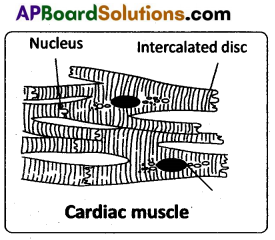
The cardiac muscle is highly resistant to fatigue,.because it has numerous sarcosomes, many molecules of myoglobin (oxygen storing pigment) and copious supply of blood which facilitate ‘continuous aerobic respiration’.
Question 13.
What are the salient features of Echinoids ?
Answer:
- The class Echinoidea includes sea urchins, heart urchins, sand dollars, sea biscuits, etc.
- The body is ovoid or discoid and covered with morable spines.
- Arms are absent; tube feet bear suckers.
- Calcareous ossicles of the body unite to form a rigid test or corona or case.
- Madreporite and anus are aboral in position.
- Ambulacral grooves are closed.
- Pedicellariae are three jawed.
- In the mouth of sea urchin a complex five jawed masticatory apparatus called Aristotle’s lantern is present (absent in the heart urchins).
- Development includes echinopluteus larva.
Examples Echinus (sea urchin), Echinocardium (heart urchin) Echinodiscus (sand dollar).
Question 14.
Compare and contrast cartilaginous and bony fishes.
Answer:
| Cartilaginous fishes | Bony fishes |
| 1) Caudal fin is heterocercal | 1) Caudal fin is diphycercal or homocercal. |
| 2) Scales if present placoid scales. | 2) Scales are ganoid, cycloid or ctenoid scales. |
| 3) Endoskeleton is entirely cartilage. | 3) Endoskeleton is bony. |
| 4) Mouth and nostrils are ventral. | 4) Mouth is usually terminal. |
| 5) Digestive tract opens into cloaca, If present. | 5) Digestive tract opens out by anus. |
| 6) Air bladder is absent. | 6) Air bladder Is often present. |
| 7) Fertilization is internal. Mostly viviparous, e.g: Scoliodon. | 7) Fertilization is external. Mostly oviparous, e.g: Catla catla |
Question 15.
Give an account of pseudopodia.
Answer:
Pseudopodia : These are found in rhizopods. The pseudopodia are temporary extensions of cytoplasm that develop in the direction of the movement. These temporary structures are useful to move on the substratum as our legs do, hence the name ‘pseudopodia’. There are four kinds of pseudopodia namely lobopodia (blunt finger-like) as in Amoeba and Entamoeba, filopodia (fibre-like) as in Euglypha, reticulopodia (net-like) as in Elphidium and axopodia or heliopodia (sun ray-like) as in Actionophrys.

![]()
Question 16.
“Prevention is better than cure. “Justify with regard to TDA abuse.
Answer:
Prevention and Control: The age-old adage of Prevention is better than cure holds true here also. Some of the measures useful for prevention and control of TDA abuse among the adolescents are:
- Avoid undue parental pressure: Every child has his/her own choice, capacity and personality. The parents should not force their children to perform beyond their capacity by comparing them with others in studies, games, etc.
- Responsibility of parents and teachers : They should look for the danger signs and counsel such students who are likely to get into the ‘trap’.
- Seeking help from peers: If peers find some one abusing drugs or alcohol, immediately it should be brought to the notice of their parents or teachers so that they can guide them appropriately.
- Education and counselling : Educating and counselling the children to face problems, stress and failures as a part of life.
- Seeking professional and medical help: A lot of help is available in the form of highly qualified psychologists, psychiatrists and de-addiction and rehabilitation programmers.
Question 17.
Draw a neat labelled diagram of the salivary apparatus of cockroach.
Answer:
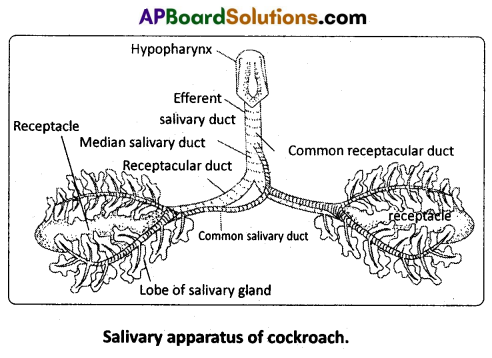
Question 18.
Write a short note on the various trophic levels in a typical ecosystem.
Answer:
Energy flows into biological systems (ecosystems) from the Sun. The biological systems of environment include several food levels called trophic levels. A trophic level is composed of those organisms which have the same source of energy and having the same number of steps away from the sun. Thus a plant’s trophic level is one, while that of a herbivore – two, and that of the first level carnivore – three. The second and third levels of the carnivores occupy fourth and fifth trophic levels respectively.

A given organism may occupy more than one trophic level simultaneously. One must remember that the trophic level represents a functional level. A given species may occupy more than one trophic level in the same ecosystem at the same time; for example, a sparrow is a primary consumer when it eats seeds, fruits, and a secondary consumer when it eats insects and worms.
![]()
Section – C (2 × 8 = 16 Marks)
III. Answer any two questions (Long answer type)
Question 19.
Describe the structure and life cycle of Ascaris lumbricoides with the help of a neat and labelled diagram.
Answer:
Structure : Sexes are separate and the sexual dimorphism is distinct. In both males and females, the body is elongated and cylindrical. Mouth is present at the extreme anterior end and is surrounded by three chitinous lips. Close to the mouth mid ven-trally, there is a small aperture called excretory pore.
Male : It has a curved posterior end which is considered the tail. The posterior end possesses a cloacal aperture and a pair of equal sized chitinous ‘pineal spicules or ‘pineal setae’ which serve to transfer the sperms during copulation.
Female : It has a straight posterior end, the tail. The female genital pore or vulva is present mid ventrally at about one third the length from mouth. The anus is present a little in front of the tail end.

Life history: Copulation takes place in the small intestine of man. After copulation, the female releases approximately two lakh eggs per day. Each egg is surrounded by ‘a protein coat with rippled surface. Hence the eggs of Ascaris are described as mammillated eggs. The protein coat is followed by a chitinous shell and a lipid layer internally. These eggs come out along with faecal matter. In the moist soil, development takes place inside the egg so that the 1st stage rhabditiform larva is produced. It undergoes the 1st moulting and becomes the 2nd stage rhabditiform larva which is considered ‘the stage infective to man’. They reach the alimentary canal of man through contaminated food and water.
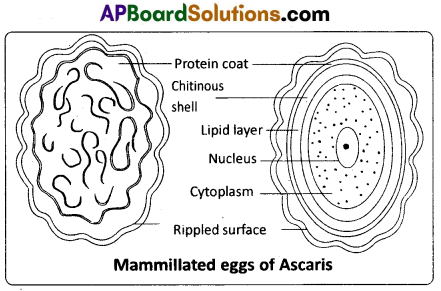
In the small intestine, the shell gets dissolved so that the 2nd stage larva is released. Now it undergoes extra intestinal migration. First it reaches the liver through the hepatic portal vein. From there it reaches the heart through the post caval vein. It goes to the lungs through the pulmonary arteries. In the alveoli of lungs it undergoes the 2nd moulting to produce the 3rdstage larva. It undergoes the 3rd moulting so that the 4th stage larva is produced in the alveoli only. It leaves the alveoli and reaches the small intestine again, through bronchi/trachea, larynx, glottis, pharynx, oesophagus and stomach. In the small intestine, it undergoes the 4th and final moulting to become a young one which attains sexual maturity within 8 to 10 weeks.
Pathogenicity : The disease caused by Ascaris lumbricoides is called ascariasis. The disease is asymptomatic if the number of worms is less. A heavy infection causes nutritional deficiency and severe abdominal pain. It also causes stunted growth in children.
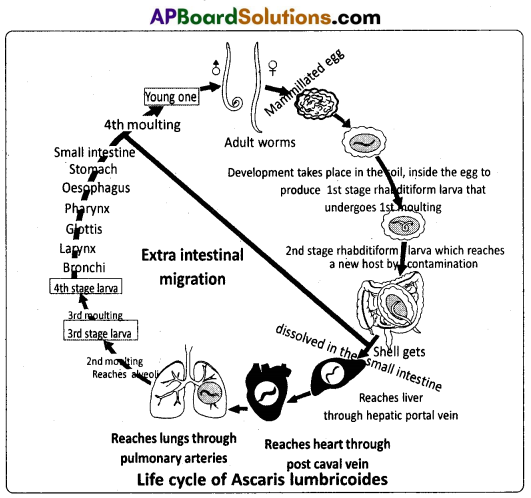
![]()
Question 20.
Describe the blood circulatory system of periplaneta and draw a neat labelled diagram of it.
Answer:
Circulatory system of Periplaneta : The circulatory system helps in the transportation of digested food, hormones etc., from one part to another in the body. Periplaneta has an open type of circulatory system as the blood, or haemohymph, flows freely within the body cavity or haemocoel. Blood vessels are poorly developed and open into spaces. Visceral organs located in the haemocoel are bathed in the blood. The three main parts associ-ated with the blood circulatory system of Periplaneta are the haemocoel, heart, and blood.
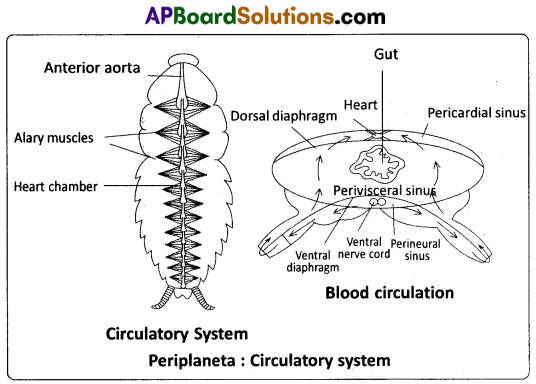
Haemocoel : The haemocoel of cockroach is divided into three sinuses by two muscular, horizontal membranes, called dorsal diaphragm or ‘pericardial septum’ and ventral diaphragm. Both the diaphragms have pores. There is a series of paired triangular muscles, called alary muscles. Every segment has one pair of these muscles situated on the lateral sides of the body. These are attached to the pericardial septum by their broad bases and to the terga by their pointed ends or apices. The three sinuses of the haemocoel are known as pericardial haemocoel or the ‘dorsal sinus’, the perivisceral haemocoel or the ‘middle sinus’ and eternal haemocoel or ‘vental sinus’ or ‘perineural sinus’. The middle sinus is very large as it contains most of the viscera. The dorsal and ventral sinuses are small as they have only heart and nerve cord, respectively.
Heart : the heart lies in the pericardial haemocoel or dorsal sinus. It is a long, muscular, contractile tube found along the mid dorsal line, beneath the terga of the thorax and abdomen. It consists of 13 chambers. Every chamber opens into the other present in front of it. Three of the thirteen chambers are situated in the thorax and ten in the abdomen. Its posterior end is closed while the anterior end is continued forward as the anterior aorta. At the posterior side of each chamber, except the last, there is a pair of small apertures called ostia’ one on each side. Ostia have valves which allow the blood to pass only into the heart from the dorsal sinus.
Blood : The blood of Periplaneta is colourless and is called haemolymph. it consists of a fluid called plasma, and free blood corpuscles or haemocytes, which are ‘phagocytic’. The phagocytes are large in size and can ‘ingest’ foreign particles such as bacteria. There is no respiratory pigment in the blood and so it plays no major role in respiration. The important functions of the blood are :
- It absorbs digested food from the alimentary canal and distributes it to the rest of the body.
- It brings nitrogenous wastes from all parts of the body to the excretory organs for their elimination.
- It carries defensive phagocytes to the places of infection where they engulf the germs and disintegrating tissue parts.
- It transports secretions of the ductless glands to the target organs.
Circulation of blood: The blood flows forward in the heart by the contractions of its chambers. At the anterior end of the heart, the blood flows into the aorta and from there it enters the sinus of the head. From the head sinus, the blood flows into the perivisceral and sternal sinuses. On contraction of the alary muscles the pericardial septum is pulled down. This increases the volume of the pericardial sinus. Hence blood flows from the perivisceral sinus into the pericardial sinus through the appertures of the pericardial septum. On relaxation of the alary muscles, the pericardial septum moves upwards to its original position. This forces the blood, to enter the chambers of the heart through the ostia from the pericardial sinus.
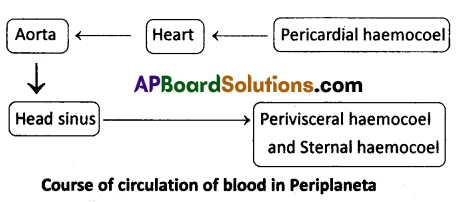
![]()
Question 21.
Describe lake as an ecosystem giving examples for various zones and biotic components of it.
Answer:
Lake Ecosystem : To understand the fundamentals of an aquatic ecosystem, let us take a ‘lake’ as an example. This is fairly a self- sustainable unit and rather a simple example that explains even the complex interactions that exist in an aquatic ecosystem.
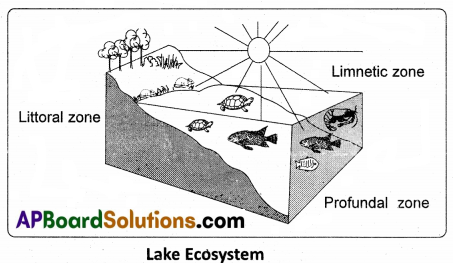
Lakes are large inland water bodies containing standing/still water (Recall: Lentic community). They are deeper than ponds (pond is not an ideal example as it is very shallow). Most lakes contain water throughout the year. In deep lakes, light cannot penetrate more than 200 meters, in depth. They are vertically stratified in relation to light intensity, temperature, pressure, etc. Deep water lakes contain three distinct zones namely
i) littoral zone
ii) limnetic zone and
iii) profundal zone,
i) Littoral zone : It is the shallow part of the lake closer to the shore. Light penetrates up to the bottom. It is ‘euphotic’ (having good light), has rich vegetation and higher rate of photosynthesis, hence rich in oxygen.
ii) Limnetic zone : It is the open water zone away from the shore. It extends up to the effective light penetration level, vertically. The imaginary line that separates the limnetic zone from the profundal zone is known as zone of compensation/compensation point / light compensation level. It is the zone of effective light penetration. Here the rate of photosynthesis is equal to the rate of respiration. Limnetic zone has no contact with the bottom of the lake.
iii) Profundal zone : It is the deep water area present below the limnetic zone and beyond the depth of effective light penetration. Light is absent. Photosynthetic organisms are absent and so the water is poor in oxygen content. It includes ^ mostly the anaerobic organisms which feed on detritus.
The organisms living in lentic habitat are classified into . pedonic forms, which live at the bottom of the lake and those living in the open waters of lakes, away from the shore vegetation are known as limnetic forms.
Biota (animal and plant life of a particular region) of the littoral zone: Littoral zone is rich with pedonic flora (especially up to the depth of the effective light penetration.) At the shore proper emergent vegetation is a abundant with firmly fixed roots in the bottom of the lake and shoots and leaves are exposed above the level of water. These are amphibious plants. Certain emergent rooted plants of littoral zone are the cattails (Typha), bulrushes (Scirpus), arrowheads (Sagittaria). Slightly deeper are the rooted plants with floating leaves, such as the water lilies (Nymphaea), Nelumbo, Trapa, etc. Still deeper are the submerged plants such as Hydrilla, Chara, Potamogeton, etc. The free floating vegetation includes Pistia, Wolffia, Lemna (duckweed), Azolla, Eichhornia, etc.
The phytoplankton of the littoral zone composed of diatoms (Coscinodiscus, Nitzschia, etc.), green algae (Volvox, Spirogyra, etc.), euglenoids (Euglena, Phacus, etc.) and dinoflagellaes (Gymnodinium, Cystodinium, etc.)
Animals, the consumers of the littoral zone, are abundant in this zone of the lake. These are categorized into zooplankton, neuston, nekton, periphyton, and benthos. The zooplankton of the littoral zone consists of ‘water fleas’ such as Daphnia rotifers and ostracods.
The animals living at the air – water interface constitute the ‘neuston’. They are of two types, the epineuston and hyponeuston. Water striders (Gerris), beetles, water bugs (Dineutes) form the epineustone / supraneuston and the hyponeuston/ infraneuston includes the ‘larvae of mosquitoes’.
The animals such as fishes, amphibians, water snakes, terrapins, insects like ‘water scorpion’ (Ranatra), ‘back swimmer’ (Notonecta), ‘dividing beetles’ (Dytiscus), capable of swimming constitute the nekton.
The animals that are attached to / creeping on the aquatic plants such as the ‘water snails’, ‘nymphs of insects’, ‘bryozoans’, ‘turbellarians’, etc., constitute the ‘periphyton’.
The animals that rest on or move on the bottom of the lake constitute the ‘benthos’ e.g. red annelids, chironomid larvae, cray fishes, some isopods, amphipods, clams, etc.
Biota of the limnetic zone : Limnetic zone is the largest zone of a lake. It is the region of rapid variations of the level of the water, temperature, oxygen availability, etc., from time to time. The limnetic zone has autotrophs {photosynthetic plants) in abundance. The chief autotrophs of this region are the phytoplankton such as the eugienoids, diatoms, cyanobacteria, dinoflagellates and green algae. The consumers of the limnetic zone are the zooplanktonic organisms such as the copepods. Fishes, frogs, water snakes, etc., form the limnetic nekton.
Biota of the profundal zone : It includes the organisms such as decomposers (bacteria), chironomid larvae, Chaoborus (Phantom larva), red annelids, clams, etc., that are capable of living in low oxygen levels. The decomposers of this zone decompose the dead plants and animals and release nutrients which are used by the biotic communities of both littoral and limnetic zones.
The lake ecosystem performs all the functions of any ecosystem and of the biosphere as a whole, i.e., conversion of inorganic substances into organic material, with the help of the radiant solar energy by the autotrophs; consumption of the autotrophs by the heterotrophs; decomposition and mineralization of the dead matter to release them back for reuse by the autotrophs (recycling of minerals).